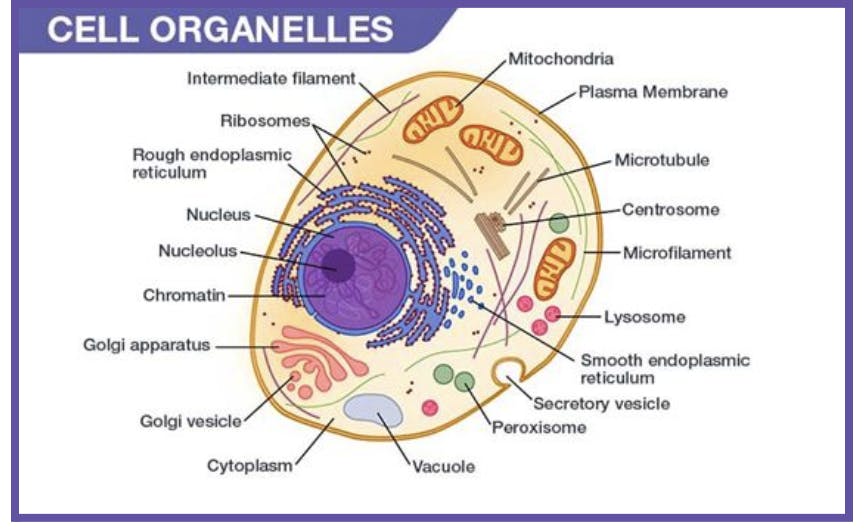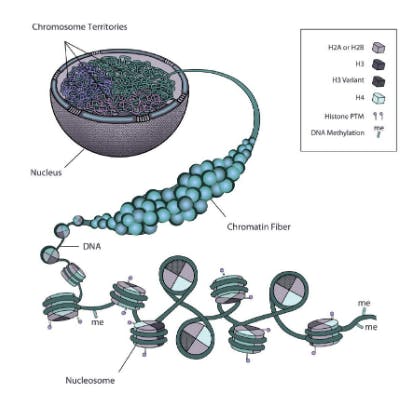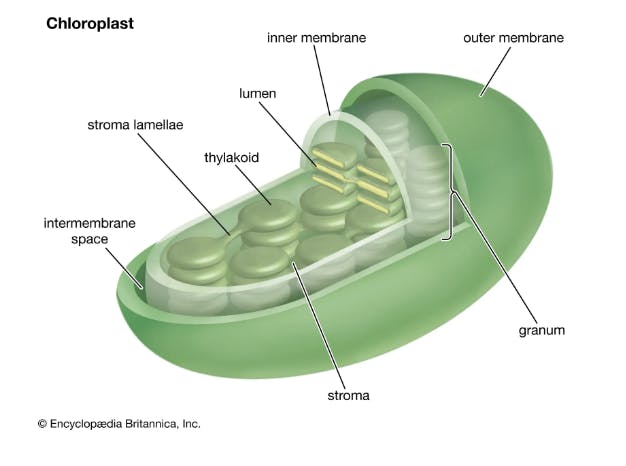TL;DR Science: Cell Organelles and Their Functions
By Srishti S.
May 22, 2023 · 4 minute read
Biology
Chemistry
Not a million, not a billion, a whopping 30 trillion cells make up the human body. From helping you see the world around you to digesting your favorite foods, cells play a pivotal role in maintaining the body’s functions. But there are structures even smaller than cells that work tirelessly behind the scenes – or rather, behind the cell membrane! There are numerous cell organelles covered in biology classes, but it is oftentimes hard to remember their specific functions. That is why making simple yet effective analogies can help!

Refer to this diagram with each analogy to identify the location of each organelle!
The cell membrane (also known as the plasma membrane) is a selectively permeable membrane on the outside of the cell that allows only certain substances to pass through. It is the outermost layer of animal cells, but it lies behind the cell wall in plant cells. Think of the cell membrane like a locked door; just like how a locked door only allows people with a key inside, the cell membrane only allows certain particles to enter and exit the cell.
Next up, the cytoplasm is the jelly-like fluid inside the cell where most cell processes occur. The fluid also helps hold all the organelles of the cell in place. The cytoplasm is like a piece of tape; both are “sticky” and help items stay in place.
The nucleus is a large organelle in the cell that acts as a “control center.” It holds the cell’s DNA in the form of chromatin, or DNA helix wrapped around histone proteins to create nucleosomes. The nucleus is often called the brain of the cell, directing all cell processes and giving “instructions” with the information from the genetic material inside it.

Moving on to the mitochondria, everyone’s favorite organelle! Commonly called the powerhouse of the cell, the mitochondria is responsible for converting food into usable energy. More specifically, the mitochondria is where aerobic respiration occurs, producing ATP energy needed to power the processes in the cell. The mitochondria is comparable to a power generator as the latter also provides electricity to many areas at once.
The endoplasmic reticulum can be further divided into two types; the Rough ER and the Smooth ER. The rough ER is a kind of passageway studded with ribosomes (more on that later); this makes it comparable to a forest trail full of dense vegetation. The rough ER is also the site of protein synthesis. The smooth ER on the other hand is responsible for producing lipids and complex carbohydrates, as well as detoxing the cell. It also acts as a highway for storage vesicles to transport such lipids through.
Ribosomes are small organelles that can be found freely floating in the cytoplasm or on the Rough ER. They are responsible for protein synthesis, making them comparable to bubble wands that produce bubbles!
The Golgi apparatus (or Golgi body) look like sacs and are responsible for packaging, sorting, and transporting materials within cells. The Golgi apparatus is similar to the post office that sorts through packages and mail and sends them to the appropriate location.
Centrioles are groups of microtubules that are responsible for helping in cell division (aiding in “cutting” the chromosomes when the time comes). This makes them comparable to a chef who cuts certain foods to prepare them for serving.
One of the most underappreciated organelles are lysosomes filled with digestive enzymes that break down waste, bacteria, viruses, and other unneeded substances. Lysosomes are often likened to sewers that collect and get rid of waste and unneeded water to keep the surrounding area clean. Lysosomes have the ability to “fuse” with vacuoles to also digest the waste inside.
Vacuoles appear different and have different functions in plant cells vs. animal cells. The vacuoles in plant cells are extremely large and store food, wastes (later removed by lysosomes), and enzymes; they are filled with fluids that help with maintaining the rigidity and structure of the plant cell. Animal cells do not always have storage vacuoles, but they are extremely small if present at all. Vacuoles can be compared to cabinets that store items that are not necessary at the present time but will be needed later.
Last but not least for this article, the chloroplast are green structures found in plant cells only that capture and convert light energy into chemical energy in the form of sugars. They contain stacks of thylakoids, or discs with the green chlorophyll pigment inside them to capture sunlight and convert it to glucose. From this description, you would have guessed that the chloroplast is the site of photosynthesis! The chloroplast is like a kitchen; just like the kitchen is where the preparation of food occurs, the chloroplast is where sunlight is turned into food (sugars) for energy in plant cells.

TL;DR:
Although cells are small on their own, there are even smaller structures found inside that constantly carry out their own unique responsibilities. Not all the organelles inside cells are covered in this short article, but hopefully the analogies listed with the main structures will help in memorizing their functions. Happy studying!
Here is a great, in-depth video about cell organelles and their functions if you want to learn more!
https://www.youtube.com/watch?v=RKmaq7jPnYM
Sources:
https://byjus.com/biology/cell-organelles/
Image Sources:
https://cdn1.byjus.com/wp-content/uploads/2018/05/Cell-Organelles.jpg
Did you enjoy this article?
About The Author
Srishti Swaminathan is a high school sophomore interested in STEM and writing. She enjoys reading, listening to music, and watching movies. If you have any comments or questions regarding this article, feel free to contact her at srishti@sciteens.org.